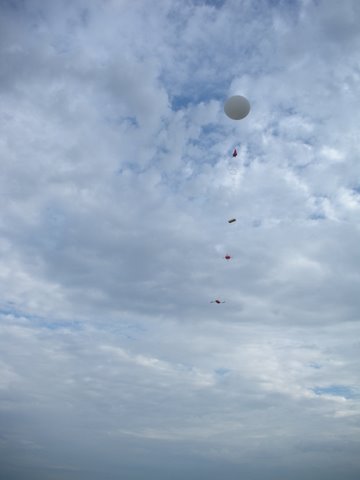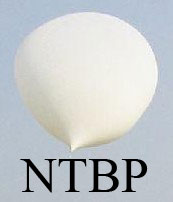NORTH TEXAS BALLOON PROJECT
THE JOHN MARK ROBBINS, NO5X
MEMORIAL FLIGHT
NTBP 18
Summer 2010, August 7, Hillsboro, Texas
Flight Announcement
NTBP is a group of amateur
(HAM) radio operators from Fort Worth and has launched balloons from Cleburne,
Clifton, and Hillsboro Airports since 1991. This is the first launch during this
last year and is funded by the amateur radio operators associated with the NTBP.
Follow us on Twitter@NTEXBP for in time information
on launch day.
Saturday's Launch 8.7.10 will show on APRS as
W5SJZ-11
Please send an email to
webmaster@ntexbp.org
for further information or to make reports during or after the actual launch.
The back up date will be August 14, 2010.
Predictions: 1,
2, 3,
4, 5

PRESS
RELEASE
NTBP
7-31-2010

ANNOUNCING
THE JOHN MARK ROBBINS MEMORIAL FLIGHT
NORTH TEXAS AMATEUR RADIO
GROUP TO FLY BALLOON FLIGHT FROM HILLSBORO
TEXAS
AIRPORT
HIGH FLIGHT
Oh! I have slipped the surly bonds of
Earth
And danced the skies on laughter-silvered wings;
Sunward I've climbed, and joined the tumbling mirth
Of sun-split clouds, — and done a hundred things
You have not dreamed of — wheeled and soared and swung
High in the sunlit silence. Hov'ring there,
I've chased the shouting wind along, and flung
My eager craft through footless halls of air. . . .
Up, up the long, delirious burning blue
I've topped the wind-swept heights with easy grace
Where never lark, or ever eagle flew —
And, while with silent, lifting mind I've trod
The high untrespassed sanctity of space,
Put out my hand, and touched the face of God.
— John Gillespie Magee, Jr
In
association with Tom Webb, WA9AFM/5, President, Oklahoma City Autopatch
Association and the North Texas Balloon Project would like to dedicate the
launch 18 to the memory of fellow ham, John Mark “Rob” Robbins.
Just two
weeks ago, John Robbins, NO5X, became a Silent Key. John was a founding member
of the Near Space Exploration Group in the OKC/Tulsa area. We conducted several
balloon launches from OKC until John's health prevented his participation and
leadership. It was John's goal to do a record setting flight for an amateur
radio balloon. He came very close, but never succeeded.
John Mark Robbins "Rob" was born in Oklahoma
City, OK on April 6, 1949 and went to be with his Lord, Friday, July 16, 2010.
John grew up a minister's son in parsonages in Oklahoma and Kansas and on the
Campus of Eastern Christian College in Maryland. He graduated Bel Air High
School in Bel Air, Maryland, in 1967. After graduation he attended Bible College
in Creswell, MD. John joined the United States Air Force in February 1969 and
was assigned to the 62nd Air Base Group, McChord AFB, Washington, from
1969-1971; Air Force Office of Investigations, Washington, DC, 1971-1975; The
United States Officer Exchange Program (NATO), 1975-1979; The Armed Forces Staff
College, Norfolk, VA, 1979-1986; Tinker Air Force Base, 1986-1991. John was
honorably discharged from the United States Air Force and worked as Service
Manager for Irwin Business Machines from 1991-2009. John was a licensed Amateur
Radio Operator and held the call sign NO5X. He dearly loved the hobby, spending
hours building, experimenting and working on electronics equipment. John was the
founding member of the Near Space Exploration Group in which a group of local
amateur radio operators attempt record breaking high altitude balloon launches
carrying radio equipment. John's quick, quick wit, humor and cheerful, generous
personality will be dearly missed. 73 John SK
The John Mark Robbins Memorial Flight, will be held by the North Texas Balloon
Project (NTEXBP) is planned for launch about 8:30 am on August 7, 2010 from the
municipal airport in Hillsboro, Texas, just south of Fort Worth and Dallas. Back
up date is August 14, 2010. Two payload packages containing sensors and amateur
radios will be carried to nearly 100,000 feet in about 90 minutes by a helium
balloon and return via parachute in about 50 minutes. Mobile recovery teams
will use position reports from the onboard GPS and APRS transmitter on 144.390
MHz and radio direction finding techniques to recover the payloads.
Pre-launch activities will begin about 7:00 am with the HF Launch Net on 7260 +/- 5 kHz, LSB beginning around
8:00 am. A cross
band repeater will be activated soon after launch. Uplink is 445.800 MHz and
downlink is 147.560 MHz. Handheld VHF radios and scanners can receive the
downlink easily. At the peak altitude ham radio operators from Texas, New
Mexico, Oklahoma, Arkansas, Louisiana, and Kansas can contact each other using
the cross band repeater. Follow us on HF radio or on
Twitter@NTEXBP
. Saturday's launch 8.7.10 will show on APRS as W5SJZ-11.
The radios used normally
have a range of about 5 to 10 miles, but that range will be extended to about
500 miles at the peak altitude. At the peak altitude, the curvature of the earth
is visible. Digital video is recorded for later playback. APRS packets transmit the balloon's location about once a minute.
NTEXBP's Tommy Davis said, "In past operations we did the launches for fun and
the enjoyment of flight. It involves many different facets of amateur radio and
thus a project that many types of amateur radio operators can enjoy together.”
There is also an educational component utilized by scouting groups, because it
involves orienteering and can be counted toward several different merit badges,
as well as by teachers for science experiments.
Davis said, “Area boy scout troops and school
classes are invited along with all that are interested.”
In the event of unfavorable weather or poor jet stream conditions, the launch
will occur at a later date. Be sure to check
www.ntexbp.org or
www.w5sjz.net and other Ham Radio forums and
news sources for later information.
The public is invited to come out to the Hillsboro
Municipal Airport, located at
Exit 3 on Interstate Highway 35W, to watch the launch.
North Texas Balloon Project is a group of amateur (HAM) radio operators from
Fort Worth and Dallas and has launched balloons from Cleburne,
Clifton,
and Hillsboro airports since 1991. This is the first launch during this year
and is funded by the amateur radio operators associated with the North Texas
Balloon Project.
Operator’s and Technical Data to follow at
www.ntexbp.org or
www.w5sjz.net. Reports, questions, APRS and
other data may be sent to NTEXBP by emailing
webmaster@ntexbp.org .
Please forward to interested Hams and ham communities. I would also appreciate
any announcement that could be made on local repeaters during allotted calls for
announcements.
TECHNICAL DETAIL
PAYLOAD 1&2
Payload:
Basic Package – APRS (part 1 of 2)
Purpose:
Position reporting, recovery support
Summary:
Utilize Automatic Position Reporting System (APRS) capabilities to allow reception by chase & recovery
teams with at least one Amateur Radio licensed operator & the required technical
equipment to track & recover the balloon launch packages
Technical Equipment
Details:
- Motorola OnCore 12-channel GPS receiver (common with voice beacon)
o
Provides location & date/time information as a serial data stream to TT4
-
TinyTrakker4 (TT4)
o Converts location &
date/time information from GPS into tones that can be transmitted through a standard
voice radio
o
Also converts analog telemetry, such as battery supply voltage & module
temperature into tones that can be transmitted through a standard voice radio
- Yaesu VX-2R
dual-band amateur transceiver that takes tones from TT4 & transmits on
144.390MHz (standard APRS frequency in US) at ˝ watt of output power
-
Diamond RH77CA dual-band antenna
-
Component power supplied by single-use lithium sulfate (LiSO4) batteries
o 3-cell pack
supplies 9VDC to all electronics (individually regulated down to 5VDC in each component) (common with voice beacon)
o With an additional
2-cell tap which supplies 6VDC to APRS
VX-2R radio
Payload:
Basic Package – Voice Beacon (part 2 of 2)
Purpose:
Position reporting, recovery support, public monitoring
Summary:
Utilize a BS2e single chip microprocessor to read internal/external temperature
sensors, to gather location & date/time information from the GPS, & to control a
text‑to‑speech module to “speak” all of this information such that it can be
received by anyone, with or without an Amateur Radio license, without the need
for any additional or specialized technical equipment other than a simple
receiver (scanner, radio, etc.)
Technical Equipment
Details:
- Motorola Oncore
12-channel GPS
receiver (common with APRS)
o Provides location &
date/time information as a serial data stream to Parallax
GPS module,
reports on APRS as W5SJZ-11.
-
Parallax BasicStamp BS2e
o
Acts as central controller for this capability
§
Generates Morse Code identification tones through the EMIC text‑to‑speech module
§ Converts location
& date/time information from Parallax GPS module into commands to the EMIC text‑to‑speech module
§
Converts digital temperature data from internal/external temperature sensors
into commands to the EMIC text‑to‑speech module
§ Reports inside
temperature, outside temperature, date, time, number of GPS satellites being received, latitude, longitude, altitude,
speed, & heading
o
Programmed in PBASIC
-
Parallax GPS Module
o Accepts location &
date/time information from Motorola OnCore GPS & provides command/status interface to BasicStamp BS2e
o
Includes an integral GPS receiver that is not utilized (we only use the
command/status interface it provides)
-
Dallas Semiconductor DS1620 Digital Temperature Sensors (Internal/External)
o
Provides digital temperature data to BasicStamp BS2e
-
Parallax EMIC Text‑to‑Speech module
o
Accepts textual data from BasicStamp BS2e and converts it into spoken audio that
can be transmitted through a standard voice radio
-
Yaesu VX-2R dual-band amateur transceiver that takes Morse Code identification
tones and generated speech from EMIC text‑to‑speech module & transmits on
146.560MHz at ˝ watt of output power
-
Diamond RH77CA dual-band antenna
-
Component power supplied by single-use lithium sulfate (LiSO4) batteries
o 3-cell pack
supplies 9VDC to all electronics (individually regulated down to 5VDC in each component) (common with
APRS)
o Separate 2-cell
pack supplies 6VDC to
voice beacon VX-2R radio
§
If primary 9VDC battery pack fails, rendering all electronics inoperative, then
by design, the voice beacon radio will remain constantly keyed (allowing
direction finding by the chase & recovery teams to continue on this constant
carrier)
Payload:
Cross-band Repeater Package
Purpose:
Short & long-distance amateur-to-amateur radio contacts
Summary:
Utilize a pair of radios coupled to a miniature repeater controller to allow
Amateur Radio licensed operators separated by either short distances (<50 miles)
or long distances (50-250 miles) to make radio contact through the balloon
package
Technical Equipment
Details:
- A
pair of Yaesu VX-2R dual-band amateur transceiver
o Act
together, one as receiver and one as transmitter
o
Radio power supplied by internal NiMH battery pack
o
Uplink radio receives on 445.800MHz
o
Uplink radio modified to provide external Carrier-operated squelch (COS)
o
Downlink radio transmits on 147.560MHz at ˝ watt of output power
- A
pair of Diamond RH77CA dual-band antennas, one per transceiver
-
NRHC-micro repeater controller
o
Provides periodic identification
o Controller power
supplied by 9VDC
alkaline battery
PAYLOAD 3
Ten
Meter Beacon
The third payload of the
flight is a ten meter beacon. This beacon was built by ham operators employed at
a local avionics shop. This home brew transmitter and Byonics controller will be
the basis of the beacon. It is operating on a frequency
28.274 mhz. The antenna
is a home brew loop antenna with an swr of 1.2 to 1. The output of
this transmitter is approximately 1 watt. This coupled with the high gain
antenna, should be heard world wide? Please report contact and we will happily
qsl the event. Email
webmaster@ntexbp.org or
FLIGHT PICTURES

|

